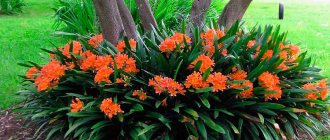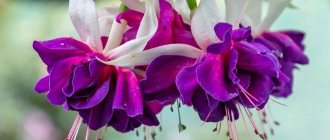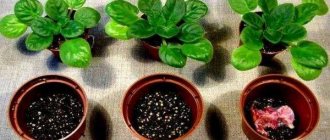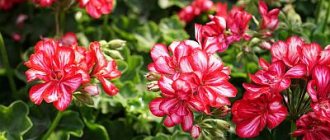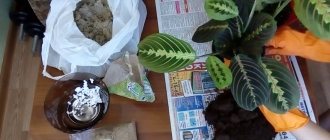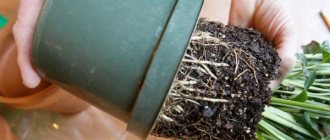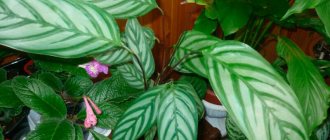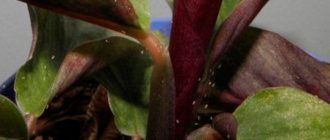The tropical guest Calathea Rufibarba, unlike most representatives of the species, cannot boast of an unusual pattern on the leaves, which in no way detracts from its decorative value. A lush dark emerald bush will not only be a wonderful decoration for your home collection and an excellent backdrop for flowering plants. The southern beauty purifies the air by absorbing toxic substances present in the atmosphere of the apartment. But growing this flower is not easy, because it is accustomed to the natural conditions of tropical forests and cannot tolerate either drought or excessive humidity.
Structural features
Calathea is a herbaceous shrub that belongs to the arrowroot family. This plant is native to the forests of Central and South America. The name calathea is translated from Greek as basket. This is due to the fact that baskets were woven from the leaves of some types of calathea. Calathea has no stem; large oval or oval-oblong leaves are located on high petioles.
The height of the plant can reach 85-90 cm.
The color of the leaves depends on the calathea variety, and the designs and patterns on the leaf plate can also be different. The root system consists of a large number of small roots.
The peculiarity of this variety is that:
- The petioles of the plant and the lower part of the leaf are covered with a small fluff, colored red. The bush is medium in size and dense if properly cared for.
- The oblong oval leaves, wavy at the edges, are located on high petioles.
- The upper part of the leaf blade has a pattern that consists of light green and dark green. The lower part is painted in a burgundy-violet tone.
- During the daytime, the leaves are positioned horizontally; at night, they rise and fold toward each other like palms.
Description of the plant
Calathea Rufibarba belongs to the genus Calathea of the family Marantaceae . This subspecies is sometimes . In the wild, the plant is distributed in the tropics of Brazil.
It is a perennial flower with a poorly developed root system. The length and width do not exceed 45-55 cm. It has a shortened stem with spreading rosettes.
The leaves of the flower are large, elongated , and are located on large petioles. The leaf plates have a ribbed surface. They are lanceolate in shape. They grow near the central vein.
The main
surface of the leaf is shiny, monochromatic, emerald .
The petioles and inner surface of the leaves are purple or burgundy . Covered with small fibers of a light shade.
It blooms with miniature, inconspicuous flowers . They are collected in inflorescences in the form of spikelets. The color of the flowers is amber-snow-white.
The plant is excellent for growing in a florarium. When growing in soil, it requires certain skills. Therefore, Calathea Rufibarba is recommended only to professional flower growers.
More details about the plant Calathea Rufibarba can be found in the photo below:
Care
Calathea rufibarba is one of those plants that develop well and grow in partial shade. Direct sunlight and intense lighting have a detrimental effect on the plant; burns may appear on the leaves and their edges begin to dry out. Western or eastern windows are perfect for placing a pot with a plant. Calathea can also grow under artificial light, provided there is 16 hours of light per day.
For calathea, the acceptable temperature range is between 20-22 degrees Celsius.
But in the summer, it feels normal even at 30 degrees Celsius, and intensive humidification of the air in the room is recommended. In winter, in the room where the plant is located, the air temperature should not drop below 18 degrees. If the tubers are overcooled for a long time, the plant will die. Calathea does not tolerate sudden changes in temperature and changes in its permanent place of growth.
Watering the plant:
- In summer, calathea is watered regularly; overwatering and waterlogging the soil is not recommended, as the roots quickly rot and the plant dies. But you can’t overdry the calathea either.
- To select the optimal watering time, it is recommended to monitor the soil when it dries out by 1-2 cm - you can water again. To do this, it is recommended to use soft water at room temperature, standing for 1-2 days.
- In winter, when the plant is dormant, it is recommended to water 2 days after the top layer of soil has dried.
Since Calathea rufibarba is a tropical plant, it is susceptible to air humidity. It is recommended to install a humidifier in the room where the plant is located or daily spray the space around the plant with a fine spray bottle of settled soft water at room temperature. Calathea of this variety does not tolerate water on the leaves. During the heating season, the pot with the plant can be placed on a tray with expanded clay or wet sand with water. Water is periodically poured into the pan.
Every year in the spring and the first part of summer it is necessary to apply fertilizers to the soil.
For this purpose, complex fertilizing for decorative foliage plants is used. This event is held once every 2 weeks. Calathea does not tolerate an excess of nutrients; it may lose the bright color of its leaves or get sick. Therefore, the dosage and frequency of fertilizer application are strictly according to the rules.
Calathea does not need pruning. It is periodically necessary to remove old and fading leaves to preserve the decorative appearance of the plant.
Problems during cultivation
Problems when growing Calathea Rufibarba, for which there is insufficient care at home, arise mainly due to poor compliance with the parameters of humidity, temperature and light. They are reflected primarily on the leaves. If the leaves of Rufibarba turn yellow and dry and spots appear on them, you need to analyze the frequency and abundance of watering, find out whether the air in the room is sufficiently humid, and whether the pot with the plant is in a draft and bright direct sunlight.
All articles about calatheas on the site can be found by following this link: CALATHEAS
All kinds of pests, such as thrips, mealybugs, scale insects, and spider mites can also cause the death of a flower. They need to be dealt with based on general recommendations depending on the degree of infection of the plant. And in order to detect them in time, the calathea is regularly examined from all sides through a magnifying glass.
Transfer
Calathea rufibarba grows well with proper care. The young plant is replanted annually in the spring and each time the size of the pot is slightly increased. Adult bushes are transferred to new pots once every 2 years.
The substrate for replanting can be bought in stores, specially designed for planting arrowroot.
You can also make it yourself by mixing peat, calcined river sand, turf soil and coniferous tree soil in equal parts. The substrate should be loose and breathable. You can also add some charcoal. A thick layer of drainage must be laid out at the bottom of the pot.
Pests
The main pests of this representative of the flora are : spider mites, mealybugs, scale insects, thrips.
For prevention, keep the flower leaves clean. They are periodically sprayed and wiped with a damp cloth.
Once a week, the plant is watered with a stream of warm shower. You must first cover the soil with cellophane.
At the first symptoms of damage, the plant is sprayed with fungicides . Actellik or other products with similar composition are perfect.
also recommend using folk remedies - a solution of garlic, ginger, potassium permanganate, alcohol, tar or laundry soap.
Reproduction
Calathea rufibarba can be propagated by dividing the bush or by seed. The bush is divided during spring replanting. For this:
- The bush is watered well during the day so that the root system can easily come out of the pot. Only adult bushes that have managed to grow a powerful root system or tubers are suitable for this method of propagation.
- One calathea can be divided into 3-5 new bushes.
- Division is done carefully so that damage to the roots is minimal.
- At the same time, the entire plant is examined for the presence of rotten or dried parts, which are removed using sharp scissors or a knife.
- Each new plant should have at least 3-4 healthy leaves.
- Plants are planted in a fresh substrate; it is recommended to add most of the peat to it first.
- After planting, the soil is watered with warm heated water and left until dry. After that, watering is carried out according to the usual system.
- Pots with young bushes are placed in a warm place.
- When new leaves are visible on the calathea, this is a sign that it has taken root and can be transferred to a pot with a regular arrowroot substrate.
- Transshipment is carried out carefully so as not to damage the root system and planted in a pot along with a lump of earth.
Propagating calathea using seeds is a longer process. To do this, you first need to prepare a substrate, which consists of equal parts of peat and river sand. Peat can be replaced with leaf soil. The seeds are carefully placed into the container from the substrates, and a greenhouse needs to be made on top.
The temperature in the room where the seedlings are germinated should be between 22-25 degrees Celsius.
The crops are periodically moistened with a spray bottle. They are also placed in shade from the sun, but not in the shade. The first picking is carried out when 2 adult leaves appear on the sprouts. They are transferred in small groups to containers with the same soil. Care and watering continue in the same mode. When the seedlings grow, they are planted in separate small pots for further cultivation.
The propagation method using seeds is not popular among amateur gardeners; it is mainly used in botanical gardens and greenhouses. Often purchased seeds do not have the promised germination rate and seed hatching percentage.
Diseases
All plant diseases are associated with improper care.
- If the leaves begin to turn yellow, fall off or rot , the soil has become waterlogged. Watering must be stopped, and the plant itself must be transplanted into a new container.
- If the leaves begin to dry out and curl , the air near the plant is too dry. Calathea Rufibarba requires constant spraying twice a day. The water should not be too cold. It is best to keep the flower in a florarium. Under these conditions, the risk of disease is significantly reduced.
Calathea Rufibarba is recommended for growing in a florarium. Responds well to subcortex and fertilizers. Due to its poorly developed system, it grows in shallow, wide areas.
Propagated by seeds and division of the root system during transplantation. Requires additional artificial lighting and high air humidity.
If you find an error, please select a piece of text and press Ctrl+Enter.
The tropical guest Calathea Rufibarba, unlike most representatives of the species, cannot boast of an unusual pattern on the leaves, which in no way detracts from its decorative value. A lush dark emerald bush will not only be a wonderful decoration for your home collection and an excellent backdrop for flowering plants. The southern beauty purifies the air by absorbing toxic substances present in the atmosphere of the apartment. But growing this flower is not easy, because it is accustomed to the natural conditions of tropical forests and cannot tolerate either drought or excessive humidity.
Description of the plant
Calathea rufibarba, or as it is also called “velvet calathea or redbeard calathea,” is a plant from the family Marantaceae, native to Brazil. The plant's common name translates to downy feather or velvet, referring to the fuzzy, fur-like structure of the lower part of the leaf, which is unusual in its own way.
The height and diameter of the Calathea Rufibarba bush rarely exceeds 55-65 cm, but sometimes you can find specimens up to 70 cm high on sale. The leaves grow on thick short petioles. At first glance they seem smooth and glossy, but if you look closely it becomes clear that their surface is velvety. The leaf blades are lanceolate, long, thin, with clearly defined veins, a wavy edge and corrugated surface, dark green upper and burgundy lower sides, covered with light reddish fibers. Under natural conditions, red-bearded calathea blooms with small, pale yellow, spike-shaped inflorescences. In culture, flowering occurs extremely rarely and reluctantly.
You can buy calathea for your home by following this link.
Several hybrids have been bred based on Calathea Redbeard. The most popular of them is Calathea rufibarba 'BlueGrass', bluegrass. Its main difference from the mother species is the dark green color of the leaves, both on the upper and lower sides.
Furry Feather (Calathea rufibarba)
Signs, advice from readers and experts
The signs regarding calathea are generally positive. One of them says that this flower is a symbol of family happiness, promotes well-being and absorbs negative energy. Thanks to the presence of this flower in the house, the owners' mood improves and a feeling of joy appears. Calathea prevents family quarrels and helps stop hostilities between relatives.
The house in which this plant is located is always open to relatives and friends.
Another sign states that people who start caring for this flower gain self-confidence, show persistence in achieving their goals, confidently defend their views and easily control negative emotions. Anyone who is willing to carefully and patiently care for a flower can check whether these signs and superstitions make sense.
Due to the whimsical nature of this plant and the need for careful care for it, not all flower growers agree on the simplicity of keeping calathea:
Julia: “In my opinion, this flower is too whimsical. Undoubtedly, it has very beautiful leaves and rather lovely flowers, and its decorative qualities are undeniable. But it requires almost 24-hour care: it takes almost all of your free time to constantly maintain the required temperature and humidity.
Busy people who want to decorate their homes with flora should pay attention to less demanding plants. And experienced gardeners will definitely like it.”
Maya: “I am absolutely delighted with the decorative qualities of the flower. Before buying it, I thought that caring for it would be very difficult, but it is not so. It is enough to maintain high humidity in the room (which a humidifier can handle) and from time to time do pest prevention. It is very important to ensure that the water in the pan does not stagnate. If you fertilize and care for this flower in time, there will be no problems or special costs.”
Elena: “I bought this flower only out of a desire to decorate my home, but over time I began to pay more and more attention to it. He is not particularly fussy to care for, and minimal effort is enough to maintain his beautiful and healthy appearance. I propagate calathea by cuttings, separating the shoots from the mother plant. The result is always successful."
Calathea Rufibarba is undoubtedly one of the most aesthetic representatives of the Marantaceae family. Caring for it will be simple and fun for experienced gardeners. Beginners in growing plants should choose a less demanding specimen or, having studied the requirements, prepare in advance the place and conditions for this unusual plant.
Calathea Lancifolia (Wonderful) (Cakathea lancifolia)
A large plant, up to a meter in height, with long (up to 45 cm) narrow wavy leaves, decorated with dark elongated spots on a light background. The reverse side is almost purple in color.
This type of calathea blooms with beautiful white flowers collected in inflorescences.
It is demanding on temperature and humidity; changes in maintenance conditions quickly affect the health of the flower.
Calathea lancifolia (Cakathea lancifolia)
Diseases and pests of Calathea Rufibarba
Pests that can interfere with the normal development of calathea are:
- spider mite;
- scale insect;
- thrips.
Often the main reason for the appearance of pests is improper care of the flower: low air humidity, inappropriate room temperature, or purchasing a new infected plant and placing it next to the calathea. As a preventive measure against pests, it is necessary to adhere to the rules of care, and when purchasing a new plant, carefully inspect it for the presence of beetles and slugs, and also pay attention to the condition of the soil and leaves.
The following methods will help get rid of the above pests:
- Treating the flower with insecticides (Karbofos, Actellik) will help against spider mites;
- when thrips appear, the leaves should be washed with a solution prepared from two spoons of laundry soap per glass of water, and in more advanced cases it is better to treat with an insecticide (Aktara, Aktellik);
- Treatment of the plant with a soap solution and subsequent treatment with an insecticide will help against scale insects.
Sooty fungus
Often a concomitant disease that accompanies the appearance of pests is sooty fungus. It appears as a black film covering the plant. The danger of its occurrence lies in the fact that the resulting film interferes with the cellular respiration of the flower and photosynthesis, and also weakens the plant. Sooty fungus appears in places where aphids and thrips infest. Therefore, if you get rid of these pests, the plaque will disappear on its own.
It will also be interesting: Anthurium Crystal - caring for a houseplant at home?
The main causes of drying and deformation of calathea leaves
The property of calathea is its colorful leaves. They lose their decorative effect in several cases.
- If the air is too dry, the plates lose their brightness, become translucent and begin to curl from the edges. It is necessary to spray and check the location of the calathea pot more often; it is quite possible that it is too close to the battery.
- The appearance of round dark or yellow spots may indicate sunlight on water droplets after spraying. You will have to change the sprayer to a smaller one and shade the window more thoroughly.
- Curling and drying of calathea leaves also indicates insufficient air humidification. You can try to build a temporary frame greenhouse and place the flower there.
- If, during the next inspection, sticky crystals of juice are found on the bottom of the leaves, then you need to check the temperature in the room. This is usually how calathea reacts to heat.
- A yellowed soft leaf of the lower tier serves as an alarm signal. This is how the plant reacts to root rotting. The calathea needs to be urgently replanted, having first removed the damaged part, dried it slightly, treated with Kornevin and after replanting the watering schedule must be adjusted.
Another reason for the loss of beauty of calathea lies in the appearance of pests. Aphids, spider mites, thrips, scale insects, and sooty fungus can settle on the leaves and stems.
The yellowed soft leaf of the lower tier serves as an alarm signal, as the plant reacts to rotting of the roots.
The most effective method is mechanical removal of pests with a rag soaked in a soap solution or nettle infusion at the rate of 1 tbsp. spoons of dry raw materials per 1 cup of boiling water. The product is infused for 2-3 hours and is suitable for use throughout the day. In case of severe damage, treatment is carried out with “Karbofos” or “Aktara”. After 10 days, the procedure is repeated in order to prevent a new infection of calathea.
Calathea Crocata
A beautifully flowering compact species, very capricious and demanding of conditions. In dry air it easily sheds its leaves. To create optimal conditions, it is recommended to grow in a florarium, where it is possible to maintain the required level of temperature and humidity.
Calathea saffron - has not only bright golden-orange flowers, but also unusual wavy leaves that are dark green on the front side and bright purple on the back.
Flowering lasts for a long time, usually in winter - in January or February. For flowering, an artificial night is created - covered with light-proof material from 18 to 8 hours. After the flower stalks appear, they return to normal daylight hours.
Calathea Crocata

